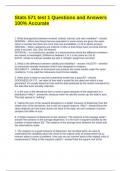Exam (elaborations)
Stats 571 test 1 Questions and Answers 100% Accurate
Stats 571 test 1 Questions and Answers 100% Accurate
1. What distinguishes between nominal, ordinal, interval, and ratio variables?
NOMINAL - When two things that are equivalent in some sense are given the same name or number but there are more than two possibilities. (1-10 in sports jerseys)
OR...
[Show more]
-
October 9, 2024
-
6
-
2024/2025
-
Exam (elaborations)
-
Questions & answers
stats 571 test 1 questions and answers 100 accura
1 what distinguishes between nominal ordinal in
2 what is the difference between validity and rel
4 is the sum of the deviations from a mean a good
-
CMN 571
-
CMN 571
Stats 571 test 1 Questions and Answers
100% Accurate
1. What distinguishes between nominal, ordinal, interval, and ratio variables? - answer
NOMINAL - When two things that are equivalent in some sense are given the same
name or number but there are more than two possibilities. (1-10 in sports jerseys)
ORDINAL - When categories are ordered. It tells us that things have occurred and the
order it occured. (1st, 2nd, 3rd winner)
INTERVAL - is a continuous variable. is a measurement where the difference between
two values is meaningful. (Difference between 1 to 3 is the same as 3 to 5)
RATIO -similar to interval variable but with 0. (Height, weight but not temp)
2. What is the difference between validity and reliability? - answer VALIDITY - whether
an instrument actually measures what it was designed to measure.
RELIABILITY - whether an instrument can produce the same results under the same
conditions. To be valid the instrument must first be reliable.
3. What does it mean to say that a statistical model has a good fit? - answer
GOODNESS OF FIT - an index of how well a model fits the data from which it was
generated. It's usually based on how well the data predicted by the model correspond to
the data that were actually collected.
4. Is the sum of the deviations from a mean a good measure of the dispersion in a
distribution? Why? - answerNo, because when we add the scores up, the total is zero.
The total spread is "nothing".
5. Taking the sum of the squared deviations is a better measure of dispersion than the
simple sum of the deviations, but is still not a good measure. Why? - answerSince the
value depends on how many scores we have in the data, we can't compare it across
samples that differ in size.
6. A better measure of dispersion is the variance. The variance is the average what? -
answerThe variance is the average dispersion. It is the sum of squares divided by the
number of observations (N). The variance is the average error between the mean and
the observations made.
7. The variance is a good measure of dispersion, but not ideal when we want to
understand the variability about the mean in the original units of measurement (e.g.,
minutes taken to solve a problem). How can we can convert back to the original units of
measurement? What is this measure called? - answerTake the square root of the
, variance to ensure that the measure of average error is in the same units as the original
measure. It is called the standard deviation.
8. What is the difference between a sample and a population? - answerSAMPLE-
statistic. A subset of the population.
POPULATION- parameter. The entire pool from which a statistical sample is drawn
9. Statistical models are often used to represent a set of data that has been collected.
All statistical models from very simple to very complex can be expressed with the
general equation: Outcomei = (Model) + errori. What is the most simple model
discussed in Chapter 2? - answerOutcome = (b) + error
B is the mean error
10. What is a 95% confidence interval? - answerThe true value of the population
parameter will fall within 95% of the samples. The limits between which the 95% of
scores fall.
11. What is the formula for computing the upper boundary of a 95% confidence interval
- answerupper boundary of confidence interval = x + (1.96 x SE)
12. What are the null and alternative hypotheses for the following question? "Is there a
relationship between the amount of gibberish that people speak and the amount vodka
jelly they've eaten?" First decide whether you are making a directional or nondirectional
alternative hypothesis. Given the hypotheses you have formulated should you use a
one-tailed or two-tailed test? - answerNull- the amount of vodka jelly does not change
the amount of gibberish words spoken
Alternative - the more vodka jell they've eaten, the more gibberish they speak
13. What are Type 1 and Type II errors? - answerTYPE 1 ERROR- occurs when we
believe that there is a genuine effect in our population, when in fact there isnt.
TYPE II ERROR- occurs when we believe that there is no effect in the population when,
in reality, there is.
14. What is statistical power? According to Cohen what is the desired level of power? -
answerThe ability of a test to find an effect. A power of .8 or 80%.
15. Psychologists are often interested in knowing the mean and the variance of a
population of interest. If the population is finite AND we have measured the
characteristic of interest for every member of the population (e.g., the dean of students
at SFSU has access to the SAT scores of all SFSU students), how can we compute the
population mean ()? - answerAdd all the SAT scores of all the students and divide it to
the total number of SFSU students.
16. For the situation described above how could we compute the population variance
(2)? Would the denominator be: n (a sample size), N (a population size), n-1, or N-1? -




